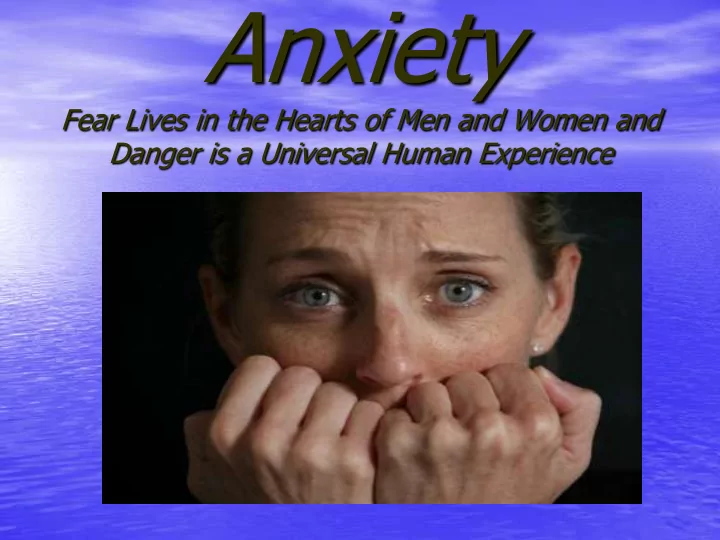

Anxiety Fear Lives in the Hearts of Men and Women and Danger is a Universal Human Experience
Anxiety: A Universal Concern
Why So Little Interest from Behavior Analysts? • Imprecise term • Metaphorical basis • Categorical error
Imprecise Term • Difficult to Define – Freud (1917) – Sidman (1964) – Levitt (1967) – McNaughton (1989) – Barlow (2002) – Friman (2007)
Colloquial Definition • Fear based avoidance of objects, activities or events that are not harmful.
A Behavior Analytic Definition • Negatively reinforced behavior emitted in the presence of events that evoke or elicit the biology of stress or fear but that pose minimal risk of harm.
Anxiety as “Category” • Specific – Conditioned suppression – Conditioned activation • General – Mental – Physiological – motoric
Select Anxiety Disorders • Separation-Anxiety Disorder • Specific Phobia • Social Phobia • Panic Disorder • Agoraphobia • Generalized Anxiety Disorder • Obsessive-Compulsive Disorder • Post-Traumatic Stress Disorder
Signs of Maladaptive Anxiety • Excessive fear-based avoidance of benign objects or events • Excessive emotional reaction • Excessive need for control • Worst case scenarioizing • Unresponsive to reason • High frequency of episodes
Downside of Avoidance 1. Reinforces notions of danger 2. Generalizes 3. Shrinks life
Fear and Non-fear Based Avoidance • Avoidance is the cardinal behavioral component of anxiety • Avoidance is a cardinal behavioral component of ASD • Not all avoidance is fear based
The Threat-based Stress Response • Prepares body for action • Bodily – Release stress hormones – Obtain fuel – Metabolize – Distribute
Prevalence of Anxiety in the ASD Population • Prevalence 40% • Overlap Between ASD and Anxiety
Developmental Implications of ASD and Anxiety • Secure attachment • Interactive play • Learning interpersonal boundaries • Learning formal social roles and rules
Signs of Anxiety in Social Interactions • Bossiness • Scripting • Frustration at shifts in play • Interrupting the play of others • Avoiding play altogether
Signs of Anxiety in the Play of Young ASD Children • Excessive: – ordering – movement of objects – body movements – echolalia – emotional reactions
Signs of Anxiety in Elementary School Aged ASD Children • Excessive – Need for control • Correcting, bargaining, arguing, taking over play – Social avoidance – Emotional reactions
Signs of Anxiety in ASD Adolescents • Social confusion • Low distress tolerance • Dependence on adults • Excessive emotional reactions
Parent and Caretaker Anxiety • Helicoptering • Cocooning • Low distress tolerance
Unintentional Anxiety Signals • Questioning • Checking • Overprotection • Reduced independence • Enabling avoidance • Attention to fear
Dilemmas for Parents and Caregivers • Encourage participation, exposure, and bravery or… • Allow avoidance or withdrawal
Dilemmas for Professionals • Encourage participation, exposure, and bravery or… • Allow avoidance or withdrawal
Strategies for Parents and Caregivers 1. Praise and attend to 5. Set reachable goals brave behavior; ignore 6. Create opportunities for more non brave change behavior 2. Model brave behavior 7. Schedule worry time and use role reversal 8. Incorporate intense or 3. Allocate responsibility; unusual interests encourage 9. Exposure, extinction, independence; allow mistakes desensitization 4. Emotional acceptance
Strategies for Professionals • Medication • Behavioral treatment
Medication • Three primary types – Benzodiazepines – Antidepressants – Beta blockers
Health Education • What is anxiety?
Externalization • To name it is to tame it • Give it a name – Goofy – Disparaging – Insulting – Sarcastic
Relaxation • Progressive muscle relaxation • Focused breathing • Meditative practices • Mindfulness
Target Irrational Thinking • All or nothing • Magical thinking • Filtering • Overgeneralization • Magnification • Emotional reasoning
Exposure Based Treatments • Exposure and response prevention • Systematic desensitization • Escape extinction • Behavioral and emotional inoculation
Exposure Treatment Real Life Examples
Effective Treatment Actual Examples
Obsessive Compulsive Disorder and Tourette’s Syndrome
Ditto
Social Phobia and Conduct Disorder
Generalized Anxiety and Habit Disorder
Insect Phobia
Initial Graduated Exposure Steps • Holding jar with • Hold a cricket for 20 crickets sec with bare hand • Touching cricket with • Allow cricket to crawl foot on pants leg • Close eyes for 60 sec • Allow cricket to crawl in room with crickets on bare arm • Pick up cricket with • Hold cricket in each tissue hand for 20 sec • Pick up cricket with gloved hand
Typical Treatment • Demystify • Name it • Exposure steps • Incentives • Change parenting • Relaxation • Breathing skills • Sell it
Recommend
More recommend